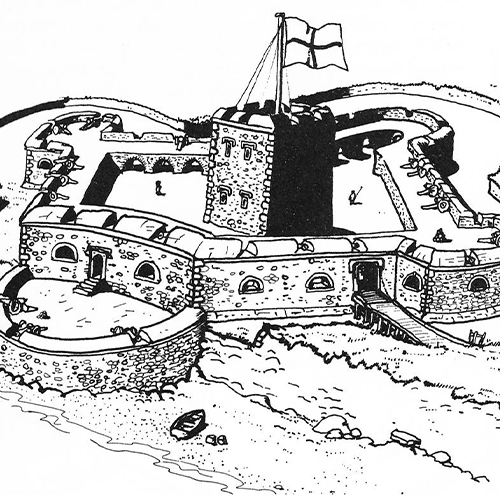Harwich, Felixstowe and Shotley have, for many years, been important docks and naval bases. As such, the area has always been protected by a number of coastal defences and forts.


1536 – 1541
Following the Dissolution of the Monasteries between 1536 and 1541, Henry VIII effectively made England an enemy of France and Spain. The risk of invasion was high, so a new chain of coastal defence forts and batteries were built around the coast. More than 75 structures were installed between South Wales and Hull, in north east England.
Here in Harwich, three blockhouses were proposed to protect the docks and town. Blockhouse of the Tower would have been in the vicinity of Ha’penny Pier. Middle House would have been close to the WWII Angel Gate Battery and The Bulwark on the Hill would have been on the headland south east of Beacon Hill.
The proposed fort at Beacon Hill, designed by Richard Lee, was never built. Instead, an earthwork, revetted with gabions was constructed. The earthwork is now at the end of the stone breakwater.
Angel Gate Battery
This area has been refortified on many occasions. A castle was built nearby in 1399, a Henry VIII blockhouse in 1543 and Half Moon Battery in 1620. By 1862 the battery was rebuilt and armed with four 68 pounder (95 cwt) guns. Finally, in WWII, a 12 pounder battery was built (part extant).
Napoleonic Period
This was probably the biggest build period, which saw works built at both Harwich and Shotley.
The Redoubt was constructed between 1807 – 1809 and was originally armed with 24 pounder guns. The building has undergone several alterations during 1905, WWI and WWII and still houses a Rifled Muzzle Loader (RML) originally installed c1860. The Redoubt is open to the public throughout the year.
Another major addition to the defences at this time were two Martello Towers at Shotley. Known as towers L and M, they were part of a chain of east coast Martello Towers built between Point Clear, Essex and Aldeburgh, Suffolk. Both towers are extant and can be seen from Ha’penny pier, both with large water towers on top of the Napoleonic structures.
Bath Side Battery
This small battery was built in 1811 just on the edge of Harwich, close to the Trinity House building. It was a small structure for only 3 guns mounted in circular emplacements. It remains visible, but only as an outline marked with bricks on a grass verge.

Back Continue